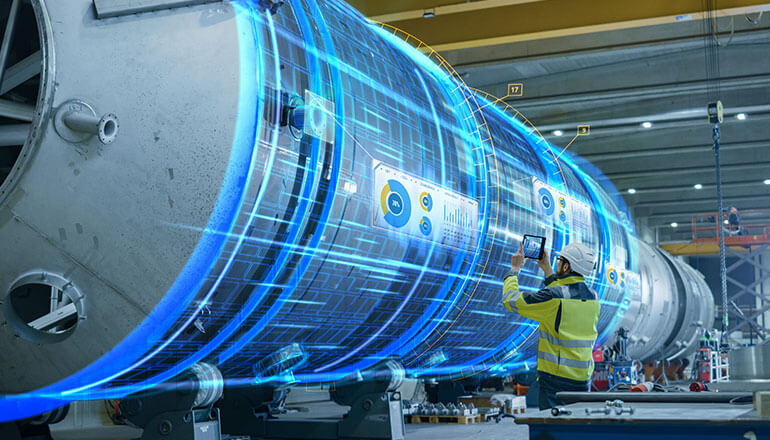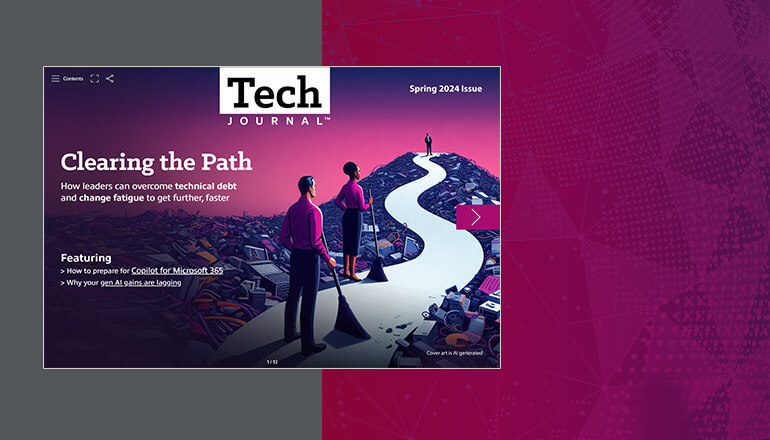Tech Journal
Driving IT Transformation With
Modern IT Operations
By Juan Orlandini / 16 Mar 2021 / Topics: Automation Data center Cloud Hybrid cloud

It’s time to rethink how IT systems are delivered — with the line of business, developers and transformation taking centre stage.
While most organisations today agree that IT transformation plays a critical role in ongoing business success and growth, the path to modernisation doesn’t always look the same for every enterprise.
At Insight, we believe that modern IT operations — an operating model that supports both on-premises, hybrid and cloud consumption models — lay the groundwork for organisations to successfully innovate, create fresh user experiences, generate new revenue streams and solve new problems.
Modern IT operations can take many forms. A recent MIT survey found that organizations take different approaches to modern architecture with roughly half deploying APIs, containers or serverless architectures. Despite these differences, there are a few key hallmarks to a successful modern IT operations strategy:
- Shifting to hybrid platforms to embrace the cloud, multicloud and DevOps strategies
- Adopting automation, toolsets, monitoring and efficient workflows to optimise the delivery of IT services
- Bridging gaps between internal groups so IT operations can deliver what developers need
- Providing developers with a familiar working experience regardless of the platform on which compute is performed
When organisations make a point of prioritising these specific goals, they experience increased efficiencies, faster time to value, optimised resources and better business agility.
Laying the groundwork for IT transformation
Creating a successful modern IT operations strategy involves a wide range of tactics and focus areas to transform the entire environment, including:
- Automation
- Service design
- DevOps integration
- Cultural transformation
Since automation is foundational, we’ll spend the rest of this article exploring its impact on transformation. However, please look out for additional articles in which we discuss the role of service design, DevOps integration and cultural transformation in detail.
Automation
Although automation isn’t a new concept in the IT world, it’s receiving renewed attention these days as IT decision-makers leverage the power of automation to save time and money while improving consistency. Replacing manual, human-driven workflows with automated tasks allows businesses to improve complicated, lengthy and error-prone processes — from the cloud, multicloud or on premises.
Additionally, not only does automation free up IT staff and resources to focus on more strategic or high-value initiatives, but it also plays a central role in modernising IT processes, deploying Artificial Intelligence (AI) and robotics, and, perhaps most importantly, establishing robust DevOps.
Automation and the role of DevOps
At the end of the day, automation should be done not to make IT’s job easier, but to make the end user’s job easier. As a result, in most organisations, this means making the developer’s job easier too, ultimately streamlining operations for the IT department.
Developers have largely flocked to the public cloud because it allows them to be hyper productive and provides tools to support easy innovation. Unfortunately, the public cloud’s popularity with developers is part of the reason why the platforms can charge so much for services.
For organisations that want to create a public cloud-like experience for developers in an on-premises context, automation is a key part of the process.
In addition to automation, achieving this goal requires enterprises to adopt new technologies and platforms that create the familiarity of the public cloud on premises for developers. This means adopting services, such as storage, database, secret management, authentication and others. It also means deploying containerised platforms and orchestration tools, artifact repositories, test and integration facilities, and instrumentation to make sure that DevOps has the visibility it needs.
First and foremost, these changes need to be done with security as the overarching goal. Once security is prioritised, organisations are ready to achieve both the governance and the velocity that’s required in today’s business landscape.
Before we discuss the importance of balancing governance and innovation, it’s worth noting that just because a process in your IT operations can be automated doesn’t necessarily mean that it should be. Automation can be resource intensive and, as such, should be used strategically and according to best practices.
Balancing governance and innovation: Speed vs. control
For most businesses, staying competitive means being innovative and agile, as well as streamlining IT operations to keep up with development. Unfortunately, organisations often sacrifice governance and control for speed and innovation.
By promoting collaboration between infrastructure and development teams — and enacting defined, repeatable and efficient processes for provisioning, deployment and testing — organizations can align DevOps with modern IT operations in a way that prioritises both innovation and governance.
Finally, considering the purpose and value of new technologies offers businesses an opportunity to sharpen their modern IT operations strategy.
For some organizations, this might mean embracing a container strategy. For others, exploring solutions like unikernels, Kubernetes or virtualised infrastructure can support modernization goals.
As always, careful consideration of workloads and their parameters should undergird any decision about deploying new technologies.
At the end of the day, adopting modern IT operations enables businesses to achieve a proper balance between governance and innovation — driving digital transformation without causing breaches, cost overruns or other problems down the line.













